Black Rhadley Hill
Hill, Mountain in Shropshire
England
Black Rhadley Hill

Black Rhadley Hill is a prominent natural landmark located in Shropshire, England. Situated in the western part of the county, it is part of the larger Shropshire Hills Area of Outstanding Natural Beauty. Despite its name, Black Rhadley Hill is not a mountain but rather a hill that rises to an elevation of approximately 400 meters (1,312 feet) above sea level.
The hill is characterized by its distinctive dark and craggy appearance, which is attributed to the presence of exposed rocks and boulders. Its geology mainly consists of limestone and dolomite, contributing to its rugged and dramatic landscape. The hill is surrounded by lush green pastures and farmland, offering picturesque views of the surrounding countryside.
Black Rhadley Hill is a popular destination for outdoor enthusiasts and nature lovers. It provides an excellent vantage point for panoramic views of the Shropshire Hills, with visibility extending to neighboring counties on clear days. The area is crisscrossed by several walking trails, allowing visitors to explore and appreciate the natural beauty of the hill and its surroundings. The hill is also home to a variety of flora and fauna, including native wildflowers and bird species.
Due to its significance as a natural landmark, Black Rhadley Hill is protected and managed by various conservation organizations. These efforts aim to preserve the ecological integrity of the area while ensuring that it remains accessible for recreational purposes.
If you have any feedback on the listing, please let us know in the comments section below.
Black Rhadley Hill Images
Images are sourced within 2km of 52.554237/-2.9708468 or Grid Reference SO3495. Thanks to Geograph Open Source API. All images are credited.


Black Rhadley Hill is located at Grid Ref: SO3495 (Lat: 52.554237, Lng: -2.9708468)
Unitary Authority: Shropshire
Police Authority: West Mercia
What 3 Words
///homes.gazed.extremely. Near Norbury, Shropshire
Nearby Locations
Related Wikis
Heath Mynd
Heath Mynd is a hill in the English county of Shropshire. At a height of 452 metres (1,483 ft) it is fairly unnotable except for its Marilyn status, a...
The Bog
The Bog is a former mining community in Shropshire, England. It lies 6 miles (10 km) north of Bishops Castle, east of the A488, at grid reference SO355979...
Linley, More
Linley is a hamlet in the civil parish of More, in Shropshire, England. The hamlet is located approximately 2 miles (3.2 km) east of the A488 road, and...
Hyssington
Hyssington (Welsh: Isatyn) is a parish in the South-Eastern corner of the historic county of Montgomeryshire in Wales and borders the county of Shropshire...
White Grit
White Grit is a small, scattered village beneath Corndon Hill in Powys, Wales, directly on the border with (and partly in) Shropshire. The nearby village...
Shelve, Shropshire
Shelve is a hamlet and former civil parish, now in the parish of Worthen with Shelve in Shropshire district of Shropshire, England. It is to the west of...
Norbury, Shropshire
Norbury (/norð burh/) is a small village and civil parish in Shropshire, England. It lies to the west of the Long Mynd and the nearest town is Bishop's...
Corndon Hill
Corndon Hill (Welsh: Cornatyn) is a hill in Powys, Mid Wales, whose isolated summit rises to 513.6 metres (1,685 ft) above sea level. It has a topographic...
Nearby Amenities
Located within 500m of 52.554237,-2.9708468Have you been to Black Rhadley Hill?
Leave your review of Black Rhadley Hill below (or comments, questions and feedback).






















